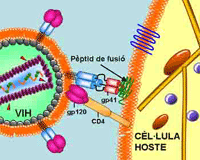Biophysicists at the UAB corner AIDS

The AIDS virus, known as Human Immunodeficiency Virus (HIV), recognises the cells it has to infect by a protein complex located in the membrane of the virus. The protein gp120 of this complex recognises specific receptors (CD4) located in the cell (for example a lymphocyte of the immune system) that will be infected. After this process of recognition, the virus protein gp41 anchors to the cell membrane so as to pull it towards the virus membrane and allow both to fuse. This membrane fusion, in which the so called fusion peptide plays an important role (the green area of gp41 in the Figure), allows the virus to "dump" its contents, and therefore its genetic material, inside the cell, where more copies of the virus are made.
In our research group, in the Biophysics Unit of the Department of Biochemistry and Molecular Biology at the UAB and the Centre for Studies in Biophysics at the UAB, we have studied the interaction of synthetic fusion peptides which imitate the fusion peptide of gp41, with model membranes, which imitate the composition and structure of the viral and cell membranes. The results obtained have allowed us to provide information on the molecular processes by which these peptides foster membrane fusion. The most remarkable result has been a contribution to solving a question, which has been so far controversial, referring to the type of structure, which enables the peptide to trigger the fusion process. According to our data, being fusogenic, the peptide adopts a structure, which is known technically as "beta leaf".
The importance o the knowledge generated by results such as these, which allow us to advance in our knowledge of the molecular processes which are the basis of viral infection, lies in the fact that they can be used in the design of new pharmacological strategies to inhibit the virus from entering cells.
This study, published in the North American journal Biochemistry, has been undertaken with funding from the "La Marató" de TV3 Foundation, which dedicated the television fundraising marathon in 2002 to AIDS.
References
Article: Buzon, V; Padros, E; Cladera, J, "Interaction of fusion peptides from HIV gp41 with membranes: A time-resolved membrane binding, lipid mixing, and structural study", BIOCHEMISTRY, 44 (40): 13354-13364 OCT 11 2005.


